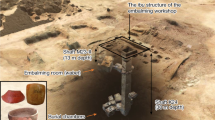Abstract
Details of mummification techniques used in dynastic Egypt have emerged from writings in subsequent ancient texts, in which the application of oils (kedros, cedrium) derived from the cedar tree have been described by Herodotus (490–425 bc)1 and by Pliny the Elder (ad 23/24–79)2. But scholars have since argued that these products were prepared from juniper trees and not from cedar3 — an assertion that is widely accepted by Egyptologists4 but which has never been verified by chemical analysis. Here we use gas chromatography to analyse the constituents of a sample of unused entombed embalming material from 1500 bc at a site in Deir el-Bahari, Egypt, and find that its components probably originated from the cedar tree. We also identify one component, guaiacol, as having notable preservative properties.
Similar content being viewed by others
Main
In ancient Egypt, the deceased were mummified in the hope that this would ensure their eternal survival. The process included removal of the internal organs, followed by desiccation and embalming of the carcass5,6; occasionally cosmetics were applied7 as a wealth of different compounds. Active enzymes have recently been isolated from embalmed bones from pharaonic Egypt8.
We prepared a methanolic extract from unused embalming material (Fig. 1) found near the mummy 'Saankh-kare', from the eighteenth dynasty, 1500 bc, at Deir el-Bahari. Gas chromatography of the extract showed no evidence of diterpenoid or triterpenoid resin components, but phenolic compounds (such as cresols, xylenols, guaiacols (2-methoxyphenols)), naphthalenes and azulenes were present (see supplementary information).
The phenolic and naphthalene derivatives probably originated from smouldering wood, with the methoxyphenols arising from lignin-degradation products that resulted from the pyrolysis of soft coniferous wood9. Dimethoxyphenols (syringols), on the other hand, are additionally formed by heating the hard wood of deciduous trees10. The presence of guaiacols without syringols in the embalming material strongly supports an origin from coniferous wood.
The brown embalming resin also contains sesquiterpenoid components, which are normally found in a fluid known as 'cedar oil'. This oil is prepared by extraction with organic solvents of wood from Cedrus atlantica and also includes junipene, cadalene, cadinatriene (calamene), cuparene and α-curcumene. Given the prevalence in the resin of guaiacols from coniferous wood-tar oils, our findings indicate that the embalming material was prepared from cedar trees.
The liquid probably originated from the water-containing fraction that is exuded before the tar from dry-distilled cedar wood. In his Naturalis Historia, Pliny the Elder2 describes the technology: “The wood of the tree is chopped up and put into ovens and heated by means of a fire packed all round outside. The first liquid that exudes flows like water down a pipe; in Syria this is called 'cedar-juice' [in Latin: cedrium], and it is so strong that in Egypt it is used for embalming the bodies of the dead.” The application of a liquid cedar product is also described by Herodotus1.
There is an unfortunate tradition of confusion between cedar and juniper trees, which has led to the erroneous assignment of Pliny's cedrium. In today's terminology as well as in ancient times, some juniper trees that are not cedar are still called cedar — for example, the American red cedar (Juniperus virginiana) and the Mediterranean 'little cedar' (Juniperus oxycedrus). In this context, our comparative investigations show that the oils or tars from juniper trees contain high amounts of cedrol or cedrene, respectively, neither of which was found in the Saankh-kare embalming material.
The surfaces of mummies embalmed with liquid tars or other liquid resinous materials are essentially free of contaminating microorganisms. The sealing effect of the embalming agents on the bone surface preserves the enzyme alkaline phosphatase inside for thousands of years8. We therefore tested the contribution of phenolic derivatives, which in the embalming agent originate from a smouldering process, and monoterpenes, which occur naturally in resinous balm, to this biochemical conservation process.
Guaiacol, p-cymene, limonene and α-pinene were tested for their effect on preserving alkaline phosphatase activity in a model embalming process, in which porcine bones were coated with one of these compounds for 35 days at room temperature. We found that guaiacol was the most effective preservative as the enzyme's specific activity was 12 times higher than that in an untreated bone control and exceeds the activity recovered from bones treated with monoterpenes (cymene has no effect; α-pinene and limonene seem to promote enzyme degradation) or with disinfectants such as phenols (see http://www.pci.chemie.uni-tuebingen.de/weser/supp_info.htm).
We conclude that liquid tars in general are most efficient in the mummification process. The methyl- and ethylguaiacol identified in the cedrium of Deir el-Bahari are characteristic representatives of wood creosotes (from the Greek 'kreas', or flesh, and 'soter', preserver). Creosotes are nowadays used for rapid smoke-drying of meat. Thus, these outstanding conserving properties confirm the statements of Herodotus and Pliny that a “strong” liquid was used for embalming in ancient Egypt.
References
Herodotus The Histories (transl. De Sélincourt, A.) Book II, 160–161 (Penguin, Harmondsworth, 1954).
Pliny (the Elder) Natural History (transl. Rackham, H.) Vol. IV, libri XII–XVI (Heinemann, London, 1960).
Lucas, A. J. Egypt. Archaeol. XVII, 13–21 (1931).
Griffiths, J. G. A. The Analyst 62, 703–707 (1937).
Germer, R. Das Geheimnis der Mumien (Artemis, Munich, 1991).
Forbes, R. J. Studies in Ancient Technology Vol. 3, 2nd edn 190–201 (Brill, Leiden, 1965).
David, A. R. in Ancient Egyptian Materials and Technology (eds Nicholson, P. T. & Shaw, I.) 372–389 (Cambridge Univ. Press, Cambridge, 2000).
Kaup, Y. et al. J. Am. Res. Center Egypt 38, 115–132 (2001).
Faix, O. et al. Holz als Roh- und Werkstoff 48, 281–285 (1990).
Toth, L. & Wittkowski, R. Chemie uns Zeit 19, 48–58 (1985).
Author information
Authors and Affiliations
Ethics declarations
Competing interests
The authors declare no competing financial interests.
Supplementary information
Rights and permissions
About this article
Cite this article
Koller, J., Baumer, U., Kaup, Y. et al. Analysis of a pharaonic embalming tar. Nature 425, 784 (2003). https://doi.org/10.1038/425784a
Issue Date:
DOI: https://doi.org/10.1038/425784a
This article is cited by
-
Biomolecular analyses enable new insights into ancient Egyptian embalming
Nature (2023)
-
Biomolecular characterization of 3500-year-old ancient Egyptian mummification balms from the Valley of the Kings
Scientific Reports (2023)
-
Virtopsy shows a high status funerary treatment in an early 18th Dynasty non-royal individual
Forensic Science, Medicine and Pathology (2017)
-
First insights into the metagenome of Egyptian mummies using next-generation sequencing
Journal of Applied Genetics (2013)
-
Traditional Tar Production from Cedrus libani A. Rich on the Taurus Mountains in Southern Turkey
Economic Botany (2008)
Comments
By submitting a comment you agree to abide by our Terms and Community Guidelines. If you find something abusive or that does not comply with our terms or guidelines please flag it as inappropriate.




